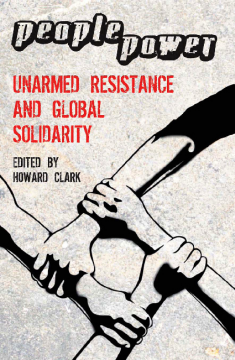
Additional Information
Book Details
Abstract
Across the world, nonviolent movements are at the forefront of resistance against repression, imperial aggression and corporate abuse. However, it is often difficult for activists in other countries to know how best to assist such movements.
The contributors to People Power place nonviolent struggles in an international context where solidarity can play a crucial role. Yet they also warn that good intentions are not enough, solidarity has to listen to local movements.
Examining movements from Zimbabwe to Burma and Palestine, the contributors assess various forms of solidarity, arguing that a central role of solidarity is to strengthen the counter-power of those resisting domination and oppression.
'Timely and stimulating'
Professor Paul Rogers, Department of Peace Studies, Bradford University
'One of the world's most knowledgeable practitioners of the technique of non-violent civil resistance is the British activist-intellectual, Howard Clark. Based on his own broad experience from several decades of assisting local or national unarmed movements, he has gathered into one bracing volume a well-organised series of essays by seasoned observers or participants from across the globe'
Professor Mary E. King, UN-affiliated University for Peace, and prize-winning author of Freedom Song: A Personal Story of the 1960s Civil Rights Movement, Mahatma Gandhi and Martin Luther King, Jr: The Power of Nonviolent Action, A Quiet Revolution: The First Palestinian Intifada and Nonviolent Resistance, and The New York Times and Democratic Transitions in Eastern Europe, 1977-2005.
'These cases are excellent analyses on how to generate non violent global transformation by working and acting locally'
Professor Kevin P Clements, Director National Centre for Peace and Conflict Studies, The University of Otago Dunedin New Zealand.
'Without shying from the difficult debates, this book gives great insight into unarmed resistance movements. Highlighting their empowerment, diversity, and creativity, it shows how these movements provide solidarity and hope for all.
Carmen Magallón, Vice-president, Spanish Association for Peace Research
Table of Contents
| Section Title | Page | Action | Price |
|---|---|---|---|
| Cover | Cover | ||
| Contents | v | ||
| List of photographs, figures and tables | viii | ||
| Acknowledgements | ix | ||
| Abbreviations | xi | ||
| Introduction by Howard Clark | 1 | ||
| Section I: Resisting Repression, Civil War and Exploitation, 2000–2008: Analyses of Unarmed Struggle | 21 | ||
| Editorial introduction | 23 | ||
| 1. Serbia - Nonviolent struggle for democracy: The role of Otpor by Danijela Nenadic and Nedad Belcevic | 26 | ||
| 1a. Serbia eight years after by Ivana Franovic | 35 | ||
| 2. Burma - Dialogue with the Generals: The sound of one hand clapping by Yeshua Moser-Puangsuwan | 39 | ||
| 3. Zimbabwe - Unarmed resistance, civil society and limits of international solidarity by Janet Cherry | 50 | ||
| 4. Columbia - Nonviolent movement for peace and international solidarity by Mauricio Garcia-Duran | 64 | ||
| 5. India - Macro violence and micro resistance: Development violence and unarmed grassroots resistance by Moses (Anand) Mazgaonkar | 76 | ||
| Section II: Nonviolent Citizens' Intervention Across Borders | 87 | ||
| Editorial introduction | 89 | ||
| 6. Making accompaniment effective by Brian Martin | 93 | ||
| 7. Developing strategy for accompaniment by Luis Enrique Eguren | 98 | ||
| 7a. With Peace Brigades International in Columbia by Louise Winstanley | 108 | ||
| 8. Civilian peacekeeping: Providing protection without sticks and carrots? by Christine Schweitzer | 112 | ||
| 8a. Making peace practical: With Nonviolent Peaceforce in Sri Lanka by Rita Webb | 122 | ||
| 9. Cross-border nonviolent advocacy during the second Palestinian intifada: The International Solidarity Movement by Veronique Dudouet | 125 | ||
| 9a. The work of the Ecumenical Accompaniment Programme in Palestine and Israel (EAPPI) by Ann Wright | 135 | ||
| 9b. International Women's Peace Service in Palestine by Angie Zelter | 138 | ||
| 10. Voices in the wilderness: Campaigning against sanctions on Iraq, 1995-2005 by Kathy Kelly and Milan Rai | 143 | ||
| Section III: Bases of Solidarity: Shared Identities, Interests and Beliefs | 151 | ||
| Editorial Introduction | 153 | ||
| 11. Women in Black: The Stony path to 'solidarity' by Cynthia Cockburn | 156 | ||
| 12. Transnational solidarity and war resistance: The case of Turkey by Andreas Speck | 164 | ||
| 13. Solidarity based on sexual orientation: Regional organising in Africa by Chesterfield Samba | 171 | ||
| 14. Diasporas: Potential partners in struggle by Andrew Rigby | 177 | ||
| 15. Global movements and local struggles: The case of World Social Forum by Stellan Vinthagen | 184 | ||
| 16. Worker solidarity and civil society cooperation: Blocking the Chinese arms shipment to Zimbabwe, April 2008 by April Carter and Janet Cherry | 191 | ||
| Section IV: Controversies in Transnational Action | 193 | ||
| Editorial introduction | 195 | ||
| 17. External financing of opposition movements by Jargen Johansen | 198 | ||
| 18. Nonviolence training and charges of Western imperialism: a guide for worried activists by George Lakey | 206 | ||
| Afterword: The chain of nonviolence by Howard Clark | 214 | ||
| Works cited | 219 | ||
| Notes on contributors | 228 | ||
| Index | 232 |
